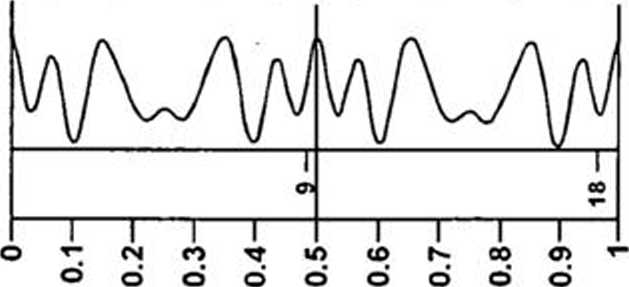9058009755
Acta Mineralogica-Petrographica, Abstract Senes 4, Szeged, 2004
CRYSTAL CHEMISTRY OF TALC: XRD AND SPECTROSCOPIC STUDIES
WIEWIÓRA. A..' PETIT, S.,2 MARTIN, F.,3 PROST, R.4
1 Institute ofGeological Sciences PAS (Instytut Nauk Geologycznyh PAN], Twarda 51-55, Warszawa, 00 818, Poland
2 HydrASA Laboratoire, Universite de Poitiers, 40 av. du Recteur Pineau, Poitiers, 86022, France
3 HydrASA Laboratoire d’Analyse Structurale et Hydrothermalism, Universite de Limoges, 123 av. Albert Thomas, Limoges, 87060, France
4 Laboratoire de Science du Sol INRA, r. de Saint-Cyr, Vcrsailles, 78026, France E-mail: wiewiora@twarda.pan.pl


In the monolithic (non powdered) samples of tale Wie-wióra (1997) determined superstructure, characterised by (W) = 18.7 A with integral senes of d^i// until / = 18, while X-ray tracings of powdered aggregates showed only all the tale common peaks. The strongest reflection for powder is 001, while it is 003 (006 of superstructure) for quasi single crystal sample. From intensities of the basal reflections, divided by Lorentz-polarisation factor for single crystal, a one-dimensional Fourier analysis was performed. It revealed inerease in the electron density, right in the middle in the tale interlayer space (Fig. 1). This additional electron density band correlates rightly with a very strong vibration at 101 cm 1 in the far infrared, for the first time obtained on monolithic sample, while this band is hardly visible in this position in the spectra from powdered sample. This band clearly indi-cates some Mg in the interlayer space of tale.
There is no direct proof for the occupation of structural positions in tale by Ca, Na, K but positive correlation of Na with tetrahedral Al (R2 = 0.71) may indicate that some Na may enter also the interlayer positions to enable charge balance due to tetrahedral substitution of Si by lower-valency cation, na-mely Al and/or Fe3*.


Fig. 1: One-dimensional [001] electron density distribution for two layer structure of tale.
Medium infrared Fourier spectroscopy revealed, in some samples of tale, vMg3OH (band present in all spectra), but also vMg2FeOH, vMgFe2OH, vFe3OH and for the first time vMg2A10H band. In the same samples 2vMg3OH, 2vMg2FeOH, 2vMgFe2OH, 2vFe3OH and 2vMg2A10H vib-rations were for the first time recorded in the near infrared spectral region. The spectra proved presence of Fe and Al substituting Mg in the octahedral positions of tale and enabled their quantification (Petit et al., 2004). Mossbauer technique, as applied to study four samples, demonstrated that 62-68% of iron is as Fe2* located in octahedral positions. Fe3* is located in the octahedral and tetrahedral positions. The determined distributions of Fe2* between M(l), M(2) and M(3) octahedral positions appear to depend on temperaturę in which experiment was performed. At 80 K the two different octahedral occupancies of Fe were differentiated, but three occupation positions at 4 K.
These XRD and spectroscopic data may mean that our understanding of tale structure as polytype 1 Aa—II (|VM), be-longing to C-l space group (morę or less disordered) may be not adequate with real structure of some individual samples. In several samples of tale, originated by transformation of e.g. micas or chlorites, superstructure is quite evident. In the light of one-dimensional electron density by Fourier trans-forms analysis, the structure may be explained as two layer arrangement with the basal spacing d(ooo = 18.7 A. In each pair of layers, having different electron densities of octahedral sheets (possibly tetrahedral, also), the even (e) orientation of octahedral sheet, intra-layer displacement along <5> vec-tor and interlayer displacement of tetrahedral sheets bclong-ing to adjacent layers along <1>, produce resultant layer displacement <0>. Such a structure (Fig. 1) gives superstructure reflections in XRD pattem.
References
Petit, S., Martin, F., Wiewióra, A., De Parseval, P., De-CARREAU, A. (2004): American Mineralogist, 80, 319-326. Wiewióra, A. (1997): Clays for our futurę: Proceedings of the llth International Clay Conference, Ottawa, Canada, 443-449.
116
vw/w. sci. u-szeged.hu/asvanytan/acta. htm
Wyszukiwarka
Podobne podstrony:
Acta Mineralogica-Petrographica, Abstract Senes 4, Szeged, 2004TEM-STUDY OF MUSCOVITE-CHLORITE MIXED
Acta Mineralogica-Petrographica, Abstract Senes 4, Szeged, 2004CHEMICAL RESISTANCE OF CEMENT-BENTONI
Acta Mineralogica-Petrographica, Abstract Senes 4, Szeged, 2004ELASTIC NETWORK OF LAMELLAR PARTICLES
Acta Mineralogica-Petrographica, Abstract Senes 4. Szeged, 2004ZEOLITE AND CLAY MINERALS AT THE CONT
Acta Mineralogica-Petrographica. Abstract Senes 4, Szeged, 2004SYNTHESIS, CHARACTERISATION AND CATAL
Acta Mineralogica-Petrographica, Abstract Senes 4. Szeged. 2004ANKARA CLAY: ITS GEOLOGY, MINERALOGY,
Acta Mineralogica-Petrographica, Abstract Senes 4, Szeged, 2004THE CRYSTAL CHEMICAL EVOLUTION OF
Acta Mineralogica-Petrographica, Abstract Senes 4, Szeged, 2004TEMPERATURĘ AND PRESSURE EFFECTS ON
Acta Mineralogica-Petrographica, Abstract Senes 4, Szeged, 2004CLAY PIGMENTS AS INDICATORS OF PAINT
Acta Mineralogica-Petrographica, Abstract Senes 4, Szeged, 2004STRUCTURAL, THERMAL AND SURFACE FORCE
Acta Mineralogica-Petrographica, Abstract Senes 4, Szeged, 2004EFFECT OF THE Ni-Al HYDROTALCITE-LIKE
Acta Mineralogica-Petrographica, Abstract Senes 4, Szeged, 2004REACTIONS OF ORGANIC MOLECULES WITH S
Acta Mineralogica-Petrographica, Abstract Senes 4, Szeged, 2004EVOLUTION OF CLAY MINERALOGY OF PALAE
Acta Mineralogica-Petrographica, Abstract Senes 4, Szeged, 2004NANO AND MICRO PARTICLES ON BENTONITE
Acta Mineralogica-Petrographica, Abstract Senes 4, Szeged, 2004MINERALOGICAL AND CRYSTAL CHEMICAL AS
więcej podobnych podstron